实验3
1.实验任务1
button.hpp源码
点击查看代码
#pragma once
#include <iostream>
#include <string>
class Button {
public:
Button(const std::string &label_);
const std::string& get_label() const;
void click();
private:
std::string label;
};
Button::Button(const std::string &label_): label{label_} {
}
inline const std::string& Button::get_label() const {
return label;
}
inline void Button::click() {
std::cout << "Button '" << label << "' clicked\n";
}
点击查看代码
#pragma once
#include <iostream>
#include <vector>
#include <algorithm>
#include "button.hpp"
// 窗口类
class Window{
public:
Window(const std::string &title_);
void display() const;
void close();
void add_button(const std::string &label);
void click_button(const std::string &label);
private:
bool has_button(const std::string &label) const;
private:
std::string title;
std::vector<Button> buttons;
};
Window::Window(const std::string &title_): title{title_} {
buttons.push_back(Button("close"));
}
inline void Window::display() const {
std::string s(40, '*');
std::cout << s << std::endl;
std::cout << "window : " << title << std::endl;
int cnt = 0;
for(const auto &button: buttons)
std::cout << ++cnt << ". " << button.get_label() << std::endl;
std::cout << s << std::endl;
}
inline void Window::close() {
std::cout << "close window '" << title << "'" << std::endl;
click_button("close");
}
inline bool Window::has_button(const std::string &label) const {
for(const auto &button: buttons)
if(button.get_label() == label)
return true;
return false;
}
inline void Window::add_button(const std::string &label) {
if(has_button(label))
std::cout << "button " << label << " already exists!\n";
else
buttons.push_back(Button(label));
}
inline void Window::click_button(const std::string &label) {
for(auto &button:buttons)
if(button.get_label() == label) {
button.click();
return;
}
std::cout << "no button: " << label << std::endl;
}
点击查看代码
#include "window.hpp"
#include <iostream>
void test(){
Window w("Demo");
w.add_button("add");
w.add_button("remove");
w.add_button("modify");
w.add_button("add");
w.display();
w.close();
}
int main() {
std::cout << "用组合类模拟简单GUI:\n";
test();
}
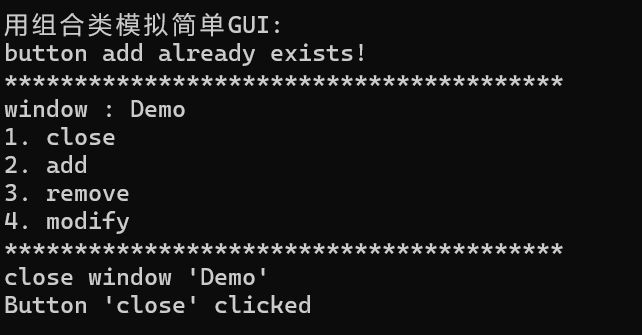
回答问题
问题1:这个范例中, Window 和 Button 是组合关系吗?
回答:是组合关系。Window类通过私有成员std::vector buttons,将Button类作为自身的组成部分,Button的创建、销毁都由Window类实现,Window类包含了Button。
问题2: bool has_button(const std::string &label) const; 被设计为私有。 思考并回答:
(1)若将其改为公有接口,有何优点或风险?
回答:优点:外部能直接判断是否有某个按钮,用着比较方便;
缺点:不安全,可能被外部不当调用。
(2)设计类时,如何判断一个成员函数应为 public 还是 private?(可从“用户是否需要”、“是否仅为内部实现细节”、“是否易破坏对象状态”等角度分析。)
回答:用户需要的核心功能设为public;仅内部用的辅助函数设为private;容易破坏对象状态的操作也设为private。
问题3: Button 的接口 const std::string& get_label() const; 返回 const std::string& 。简要说明以下两种接口设计在性能和安全性方面的差异。
接口1: const std::string& get_label() const;
接口2: const std::string get_label() const;
回答:性能:接口1返回引用,不用拷贝,更快;接口2返回拷贝,耗时,并且占内存。
安全性:两者都通过const保证返回值不可以被修改,成员函数也被const修饰,无法修改,两个都是安全的。
问题4:把代码中所有 xx.push_back(Button(xxx)) 改成 xx.emplace_back(xxx) ,观察程序是否正常运行;查阅资料,回答两种写法的差别。
回答:能。差别:push_back先造临时对象再拷贝进容器;emplace_back直接在容器里造对象,没有拷贝,效率更高。
2.实验任务2
task2.cpp源码
点击查看代码
#include <iostream>
#include <vector>
void test1();
void test2();
void output1(const std::vector<int> &v);
void output2(const std::vector<int> &v);
void output3(const std::vector<std::vector<int>>& v);
int main() {
std::cout << "深复制验证1: 标准库vector<int>\n";
test1();
std::cout << "\n深复制验证2: 标准库vector<int>嵌套使用\n";
test2();
}
void test1() {
std::vector<int> v1(5, 42);
const std::vector<int> v2(v1);
std::cout << "**********拷贝构造后**********\n";
std::cout << "v1: "; output1(v1);
std::cout << "v2: "; output1(v2);
v1.at(0) = -1;
std::cout << "**********修改v1[0]后**********\n";
std::cout << "v1: "; output1(v1);
std::cout << "v2: "; output1(v2);
}
void test2() {
std::vector<std::vector<int>> v1{{1, 2, 3}, {4, 5, 6, 7}};
const std::vector<std::vector<int>> v2(v1);
std::cout << "**********拷贝构造后**********\n";
std::cout << "v1: "; output3(v1);
std::cout << "v2: "; output3(v2);
v1.at(0).push_back(-1);
std::cout << "**********修改v1[0]后**********\n";
std::cout << "v1: \n"; output3(v1);
std::cout << "v2: \n"; output3(v2);
}
// 使用xx.at()+循环输出vector<int>数据项
void output1(const std::vector<int> &v) {
if(v.size() == 0) {
std::cout << '\n';
return;
}
std::cout << v.at(0);
for(auto i = 1; i < v.size(); ++i)
std::cout << ", " << v.at(i);
std::cout << '\n';
}
// 使用迭代器+循环输出vector<int>数据项
void output2(const std::vector<int> &v) {
if(v.size() == 0) {
std::cout << '\n';
return;
}
auto it = v.begin();
std::cout << *it;
for(it = v.begin()+1; it != v.end(); ++it)
std::cout << ", " << *it;
std::cout << '\n';
}
// 使用auto for分行输出vector<vector<int>>数据项
void output3(const std::vector<std::vector<int>>& v) {
if(v.size() == 0) {
std::cout << '\n';
return;
}
for(auto &i: v)
output2(i);
}
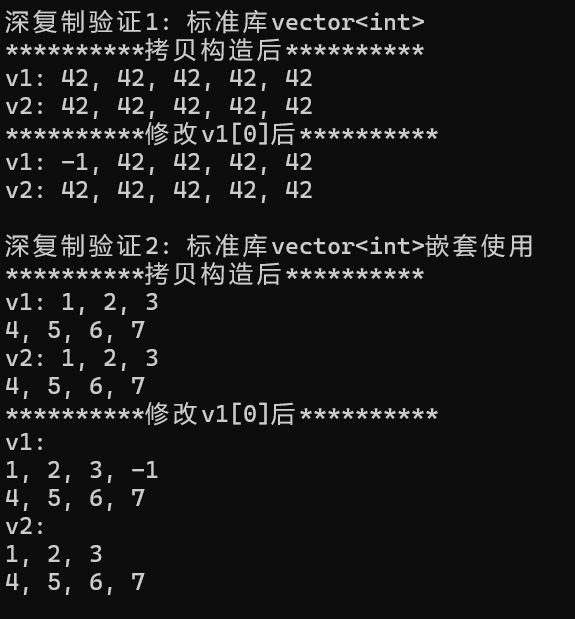
回答问题
问题1:测试模块1中这两行代码分别完成了什么构造? v1 、 v2 各包含多少个值为 42 的数据项?
回答:第一行是带初始值的构造,v1有5个42;第二行是复制构造,v2也有5个42。
问题2:测试模块2中这两行代码执行后, v1.size() 、 v2.size() 、 v1[0].size() 分别是多少?
回答:v1.size()=2,v2.size()=2,v1[0].size()=3。
问题3:测试模块1中,把 v1.at(0) = -1; 写成 v1[0] = -1; 能否实现同等效果?两种用法有何区别?
回答:能。区别:第一种会做检查边界,更安全;第二种不检查。
问题4:测试模块2中执行 v1.at(0).push_back(-1); 后
(1) 用以下两行代码,能否输出-1?为什么?
回答:可以输出-1。r作为vector的引用,通过r.at(r.size()-1)就能访问到末尾元素-1。
(2)r定义成用 const & 类型接收返回值,在内存使用上有何优势?有何限制?
回答:优势:不用拷贝,省内存;限制:const让r不能修改所指向的对象。
问题5:观察程序运行结果,反向分析、推断:
(1) 标准库模板类 vector 的复制构造函数实现的是深复制还是浅复制?
回答:深复制,改v1不影响v2,说明两者内存独立,是深复制。
(2) vector
回答:普通vector的at()返回int&;const的返回const int&;必须重载,否则const对象用不了at()。
3.实验任务3
vectorInt.hpp源码
点击查看代码
#pragma once
#include <cstdlib>
#include <iostream>
// 动态int数组对象类
class vectorInt{
public:
vectorInt();
vectorInt(int n_);
vectorInt(int n_, int value);
vectorInt(const vectorInt &vi);
~vectorInt();
int size() const;
int& at(int index);
const int& at(int index) const;
vectorInt& assign(const vectorInt &vi);
int* begin();
int* end();
const int* begin() const;
const int* end() const;
private:
int n; // 当前数据项个数
int *ptr; // 数据区
};
vectorInt::vectorInt():n{0}, ptr{nullptr} {
}
vectorInt::vectorInt(int n_): n{n_}, ptr{new int[n]} {
}
vectorInt::vectorInt(int n_, int value): n{n_}, ptr{new int[n_]} {
for(auto i = 0; i < n; ++i)
ptr[i] = value;
}
vectorInt::vectorInt(const vectorInt &vi): n{vi.n}, ptr{new int[n]} {
for(auto i = 0; i < n; ++i)
ptr[i] = vi.ptr[i];
}
vectorInt::~vectorInt() {
delete [] ptr;
}
int vectorInt::size() const {
return n;
}
const int& vectorInt::at(int index) const {
if(index < 0 || index >= n) {
std::cerr << "IndexError: index out of range\n";
std::exit(1);
}
return ptr[index];
}
int& vectorInt::at(int index) {
if(index < 0 || index >= n) {
std::cerr << "IndexError: index out of range\n";
std::exit(1);
}
return ptr[index];
}
vectorInt& vectorInt::assign(const vectorInt &vi) {
if(this == &vi)
return *this;
int *ptr_tmp;
ptr_tmp = new int[vi.n];
for(int i = 0; i < vi.n; ++i)
ptr_tmp[i] = vi.ptr[i];
delete[] ptr;
n = vi.n;
ptr = ptr_tmp;
return *this;
}
int* vectorInt::begin() {
return ptr;
}
int* vectorInt::end() {
return ptr+n;
}
const int* vectorInt::begin() const {
return ptr;
}
const int* vectorInt::end() const {
return ptr+n;
}
点击查看代码
#include "vectorInt.hpp"
#include <iostream>
#include <stdlib.h>
void test1();
void test2();
void output1(const vectorInt &vi);
void output2(const vectorInt &vi);
int main() {
std::cout << "测试1: \n";
test1();
std::cout << "\n测试2: \n";
test2();
}
void test1() {
int n;
std::cout << "Enter n: ";
std::cin >> n;
vectorInt x1(n);
for(auto i = 0; i < n; ++i)
x1.at(i) = (i+1)*10;
std::cout << "x1: "; output1(x1);
vectorInt x2(n, 42);
vectorInt x3(x2);
x2.at(0) = -1;
std::cout << "x2: "; output1(x2);
std::cout << "x3: "; output1(x3);
}
void test2() {
const vectorInt x(5, 42);
vectorInt y;
y.assign(x);
std::cout << "x: "; output2(x);
std::cout << "y: "; output2(y);
}
// 使用xx.at()+循环输出vectorInt对象数据项
void output1(const vectorInt &vi) {
if(vi.size() == 0) {
std::cout << '\n';
return;
}
std::cout << vi.at(0);
for(auto i = 1; i < vi.size(); ++i)
std::cout << ", " << vi.at(i);
std::cout << '\n';
}
// 使用迭代器+循环输出vectorInt对象数据项
void output2(const vectorInt &vi) {
if(vi.size() == 0) {
std::cout << '\n';
return;
}
auto it = vi.begin();
std::cout << *it;
for(it = vi.begin()+1; it != vi.end(); ++it)
std::cout << ", " << *it;
std::cout << '\n';
}
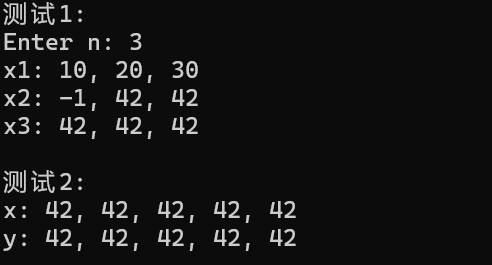
回答问题
问题1:当前验证性代码中, vectorInt 接口 assign 实现是安全版本。如果把 assign 实现改成版本2,逐条指出版本 2存在的安全隐患和缺陷。(提示:对比两个版本,找出差异化代码,加以分析)
回答:(1)版本2的隐患:如果用对象自己给自己赋值(x.assign(x)),会先把自己的内存释放掉,再去访问已经释放的内存,导致程序崩溃。
(2)new失败会让对象处于“内存没了还没赋值好”的状态,之后用这个对象就会出错。
问题2:当前验证性代码中,重载接口 at 内部代码完全相同。若把非 const 版本改成如下实现,可消除重复并遵循“最小化接口”原则(未来如需更新接口,只更新const接口,另一个会同步)。
查阅资料,回答:
(1) static_cast<const vectorInt>(this) 的作用是什么?转换前后 this 的类型分别是什么?转换目的?
回答:把this从vectorInt转成const vectorInt,目的是调用const版本的at(),复用代码。
(2) const_cast<int&> 的作用是什么?转换前后的返回类型分别是什么?转换目的?
回答:把const int&转成int&,目的是让非const对象能通过at()修改元素。
问题3: vectorInt 类封装了 begin() 和 end() 的const/非const接口。
(1)以下代码片段,分析编译器如何选择重载版本,并总结这两种重载分别适配什么使用场景。
回答:v1调用非const版本,v2调用const版本。非const适配要修改元素的场景;const适配只读取的场景。
(2)拓展思考(选答):标准库迭代器本质上是指针的封装。 vectorInt 直接返回原始指针作为迭代器,这种设计让你对迭代器有什么新的理解?
回答:迭代器核心是遍历元素,连续内存下用指针当迭代器,简单好用。
问题4:以下两个构造函数及 assign 接口实现,都包含内存块的赋值/复制操作。使用算法库
回答:可以。功能:(1)把ptr开始的n个元素设为value;(2)把vi.ptr的元素拷贝到ptr;(3)把vi.ptr的元素拷贝到ptr_tmp,赋值安全。
4.实验任务4
matrix.hpp源码
点击查看代码
#pragma once
#include <iostream>
#include <algorithm>
#include <cstdlib>
// 类Matrix声明
class Matrix {
public:
Matrix(int rows_, int cols_, double value = 0); // 构造rows_*cols_矩阵对象, 初值value
Matrix(int rows_, double value = 0); // 构造rows_*rows_方阵对象, 初值value
Matrix(const Matrix &x); // 深复制
~Matrix();
void set(const double *pvalue, int size); // 按行复制pvalue指向的数据,要求size=rows*cols,否则报错退出
void clear(); // 矩阵对象数据项置0
const double& at(int i, int j) const; // 返回矩阵对象索引(i,j)对应的数据项const引用(越界则报错后退出)
double& at(int i, int j); // 返回矩阵对象索引(i,j)对应的数据项引用(越界则报错后退出)
int rows() const; // 返回矩阵对象行数
int cols() const; // 返回矩阵对象列数
void print() const; // 按行打印数据
private:
int n_rows; // 矩阵对象内元素行数
int n_cols; // 矩阵对象内元素列数
double *ptr; // 数据区
};
点击查看代码
#include "matrix.hpp"
#include <iostream>
#include <cstdlib>
Matrix::Matrix(int rows, int cols, double value) {
n_rows = rows;
n_cols = cols;
if (rows <= 0 || cols <= 0) {
std::cerr << "错误:行列数不能为非正数\n";
std::exit(1);
}
ptr = new double[rows * cols];
for (int i = 0; i < rows * cols; i++) {
ptr[i] = value;
}
}
Matrix::Matrix(int rows, double value) {
n_rows = rows;
n_cols = rows;
if (rows <= 0) {
std::cerr << "错误:行列数不能为非正数\n";
std::exit(1);
}
ptr = new double[rows * rows];
for (int i = 0; i < rows * rows; i++) {
ptr[i] = value;
}
}
Matrix::Matrix(const Matrix &x) {
n_rows = x.n_rows;
n_cols = x.n_cols;
ptr = new double[n_rows * n_cols];
for (int i = 0; i < n_rows * n_cols; i++) {
ptr[i] = x.ptr[i];
}
}
Matrix::~Matrix() {
delete[] ptr;
}
void Matrix::set(const double *pvalue, int size) {
if (size != n_rows * n_cols) {
std::cerr << "错误:数据长度与矩阵大小不匹配\n";
std::exit(1);
}
for (int i = 0; i < size; i++) {
ptr[i] = pvalue[i];
}
}
void Matrix::clear() {
for (int i = 0; i < n_rows * n_cols; i++) {
ptr[i] = 0.0;
}
}
const double& Matrix::at(int i, int j) const {
if (i < 0 || i >= n_rows || j < 0 || j >= n_cols) {
std::cerr << "错误:索引越界\n";
std::exit(1);
}
return ptr[i * n_cols + j];
}
double& Matrix::at(int i, int j) {
return const_cast<double&>(static_cast<const Matrix*>(this)->at(i, j));
}
int Matrix::rows() const {
return n_rows;
}
int Matrix::cols() const {
return n_cols;
}
void Matrix::print() const {
for (int i = 0; i < n_rows; i++) {
for (int j = 0; j < n_cols; j++) {
std::cout << ptr[i * n_cols + j];
if (j != n_cols - 1) {
std::cout << ", ";
}
}
std::cout << std::endl;
}
}
点击查看代码
#include <iostream>
#include <cstdlib>
#include "matrix.hpp"
void test1();
void test2();
void output(const Matrix &m, int row_index);
int main() {
std::cout << "测试1: \n";
test1();
std::cout << "\n测试2: \n";
test2();
}
void test1() {
double x[1000] = {1, 2, 3, 4, 5, 6, 7, 8, 9, 10};
int n, m;
std::cout << "Enter n and m: ";
std::cin >> n >> m;
Matrix m1(n, m); // 创建矩阵对象m1, 大小n×m
m1.set(x, n*m); // 用一维数组x的值按行为矩阵m1赋值
Matrix m2(m, n); // 创建矩阵对象m2, 大小m×n
m2.set(x, m*n); // 用一维数组x的值按行为矩阵m1赋值
Matrix m3(n); // 创建一个n×n方阵对象
m3.set(x, n*n); // 用一维数组x的值按行为矩阵m3赋值
std::cout << "矩阵对象m1: \n"; m1.print();
std::cout << "矩阵对象m2: \n"; m2.print();
std::cout << "矩阵对象m3: \n"; m3.print();
}
void test2() {
Matrix m1(2, 3, -1);
const Matrix m2(m1);
std::cout << "矩阵对象m1: \n"; m1.print();
std::cout << "矩阵对象m2: \n"; m2.print();
m1.clear();
m1.at(0, 0) = 1;
std::cout << "m1更新后: \n";
std::cout << "矩阵对象m1第0行 "; output(m1, 0);
std::cout << "矩阵对象m2第0行: "; output(m2, 0);
}
// 输出矩阵对象row_index行所有元素
void output(const Matrix &m, int row_index) {
if(row_index < 0 || row_index >= m.rows()) {
std::cerr << "IndexError: row index out of range\n";
exit(1);
}
std::cout << m.at(row_index, 0);
for(int j = 1; j < m.cols(); ++j)
std::cout << ", " << m.at(row_index, j);
std::cout << '\n';
}
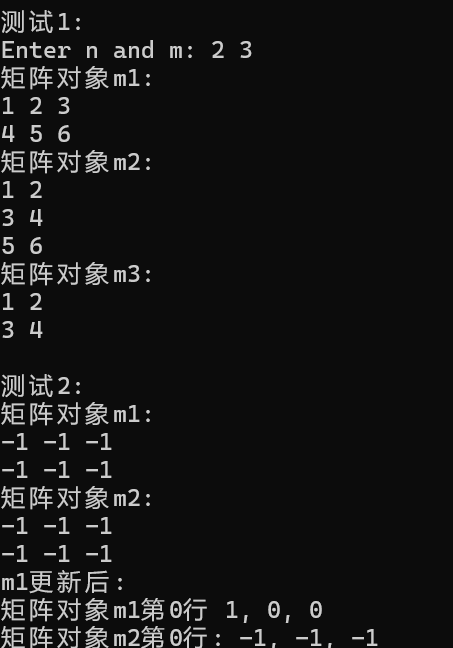
5.实验任务5
contact.hpp源码
点击查看代码
#pragma once
#include <iostream>
#include <string>
// 联系人类
class Contact {
public:
Contact(const std::string &name_, const std::string &phone_);
const std::string &get_name() const;
const std::string &get_phone() const;
void display() const;
private:
std::string name; // 必填项
std::string phone; // 必填项
};
Contact::Contact(const std::string &name_, const std::string &phone_):name{name_}, phone{phone_} {
}
const std::string& Contact::get_name() const {
return name;
}
const std::string& Contact::get_phone() const {
return phone;
}
void Contact::display() const {
std::cout << name << ", " << phone;
}
点击查看代码
# pragma once
#include <iostream>
#include <string>
#include <vector>
#include <algorithm>
#include "contact.hpp"
// 通讯录类
class ContactBook {
public:
void add(const std::string &name, const std::string &phone); // 添加联系人
void remove(const std::string &name); // 移除联系人
void find(const std::string &name) const; // 查找联系人
void display() const; // 显示所有联系人
size_t size() const;
private:
int index(const std::string &name) const; // 返回联系人在contacts内索引,如不存在,返回-1
void sort(); // 按姓名字典序升序排序通讯录
private:
std::vector<Contact> contacts;
};
void ContactBook::add(const std::string &name, const std::string &phone) {
if(index(name) == -1) {
contacts.push_back(Contact(name, phone));
std::cout << name << " add successfully.\n";
sort();
return;
}
std::cout << name << " already exists. fail to add!\n";
}
void ContactBook::remove(const std::string &name) {
int i = index(name);
if(i == -1) {
std::cout << name << " not found, fail to remove!\n";
return;
}
contacts.erase(contacts.begin()+i);
std::cout << name << " remove successfully.\n";
}
void ContactBook::find(const std::string &name) const {
int i = index(name);
if(i == -1) {
std::cout << name << " not found!\n";
return;
}
contacts[i].display();
std::cout << '\n';
}
void ContactBook::display() const {
for(auto &c: contacts) {
c.display();
std::cout << '\n';
}
}
size_t ContactBook::size() const {
return contacts.size();
}
// 待补足1:实现index函数
int ContactBook::index(const std::string &name) const {
for (int i = 0; i < contacts.size(); ++i) {
if (contacts[i].get_name() == name) {
return i;
}
}
return -1;
}
// 待补足2:实现sort函数
void ContactBook::sort() {
std::sort(contacts.begin(), contacts.end(),
[](const Contact &a, const Contact &b) {
return a.get_name() < b.get_name();
}
);
}
点击查看代码
#include "contactBook.hpp"
void test() {
ContactBook contactbook;
std::cout << "1. add contacts\n";
contactbook.add("Bob", "18199357253");
contactbook.add("Alice", "17300886371");
contactbook.add("Linda", "18184538072");
contactbook.add("Alice", "17300886371");
std::cout << "\n2. display contacts\n";
std::cout << "There are " << contactbook.size() << " contacts.\n";
contactbook.display();
std::cout << "\n3. find contacts\n";
contactbook.find("Bob");
contactbook.find("David");
std::cout << "\n4. remove contact\n";
contactbook.remove("Bob");
contactbook.remove("David");
}
int main() {
test();
}
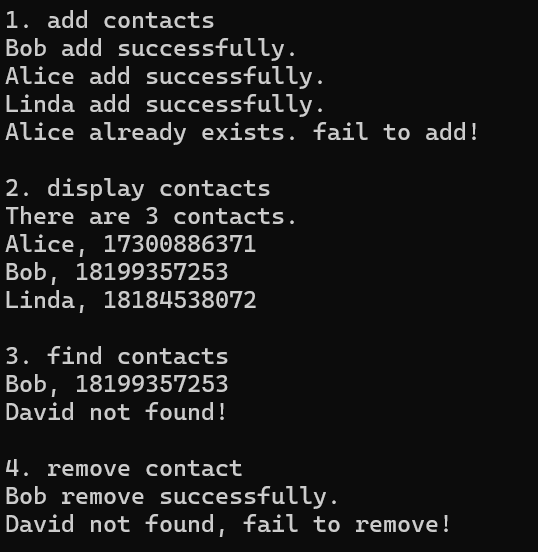




 浙公网安备 33010602011771号
浙公网安备 33010602011771号